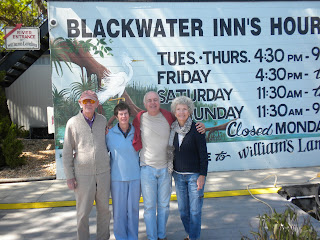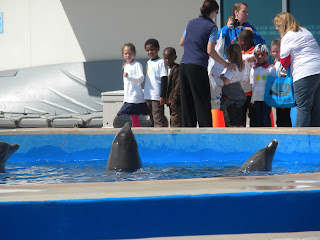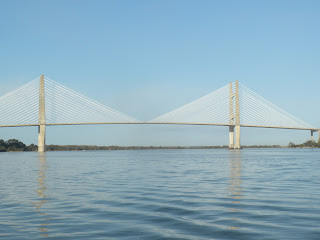Back at Six Mile Creek, we had a rainstorm but this rainbow raised our hopes for better weather in the morning.
March 19-20: Ortega River: Provisioning and boat repairs saw us spending two days in the Ortega River Yacht Marina which is just north of Jacksonville. The Captain aka "Mister Fixit" had a major repair job on his hands. Our aft electric head (marine toilet) decided to give up the ghost. Fortunately, there was a West Marine store within one block of the marina and they had the identical item in stock. So out with the old and in with the new. Took a few hours but the operation was completed successfully.
March 21: Back on the Loop and onto Fernandina: Taking advantage of the Ebb tide again saw us under way and cruising past Jacksonville at 9-10 knots to reconnect with the Inter Coastal Waterway (ICW).
Last Bascule Bridge for a while with Jacksonville in the background.
This section of the Inter Coastal Waterway is quite shallow and narrow. These folks have to be very serious boaters to build such long docks out into the water. We estimated that some of them are over 500 feet long.
March 22-26: Fernandina Beach: Our first night in Fernandina, we picked up a town mooring and planned to dinghy into the town the next day to explore. However, strong winds and a forecast for severe thunderstorms over the next few days caused us to adapt our plans. We made arrangements to move into the Fernandina Harbor Marina. We were blessed with good weather and strolled into town.
Fernandina Beach which is located on Amelia Island is a thriving, town with lots of history, quaint shops and a plethora of good restaurants. We had an excellent dinner at the 29 South restaurant.
According to the Amelia Island Museum of History, over the last 400 years, Amelia Island has been under 8 different flags. First the French from 1562-1565, the Spanish from 1566-1763, the English from 1763-1783, the Spanish 1783-1821 (with 3 interruptions), Patriots who overthrew Spanish rule, Green Cross of Florida, Mexican Rebels, the United States 1821 to present with an interruption during Confederate control during the Civil War.
The Historic District of Fernandina Beach is a 50-block area located at the north end of Amelia Island and recognized on the National Register of historic Places. The town of Fernandina was officially established in 1811 and named for King Ferdinand VII of Spain. In 1853, the town site moved just south to take advantage of the new Florida Railroad and the subsequent tourism boom. The original town now called Old Town Fernandina, still remains and celebrated its 200th anniversary in 2011.
Lesesne house is built of hand-hewn timber and wooden pegs. Judge John Friend purchased the house in 1868 and family descendants still occupy the house.
Nassau County Courthouse built in 1891 during Fernandina's Golden Era is one of the finest examples of surviving Victorian courthouses in Florida and is the oldest county courthouse in continuous use.
The US Post Office built in 1910. It was designed in the style of the Medici Palace in Florence. On the second floor is a fully restored courtroom which served the area early in the 20th Century.
The Captain with dreams of a new car.
This tug boat was pulling a long, flat cargo....
that went on ...
and on...
and on...
until its buddy boat brought up the rear. Good thing that the waters were calm that day.
The weather promptly turned ugly for the next two days and severe thunderstorms and heavy rains kept us both on the boat and stuck in Fernandina for extra days. Not a bad spot to be stuck in but we are hoping the weather improves so that we can leave for Cumberland Island tomorrow.
This is the type of weather and sea conditions that kept us in Fernandina so long.
The weather promptly turned ugly for the next two days and severe thunderstorms and heavy rains kept us both on the boat and stuck in Fernandina for extra days. Not a bad spot to be stuck in but we are hoping the weather improves so that we can leave for Cumberland Island tomorrow.
This is the type of weather and sea conditions that kept us in Fernandina so long.








































































